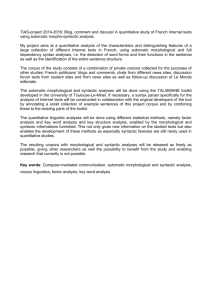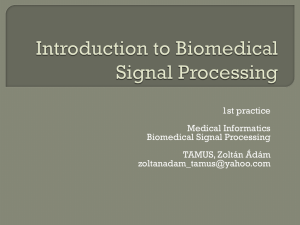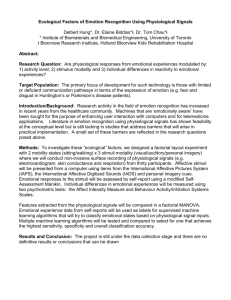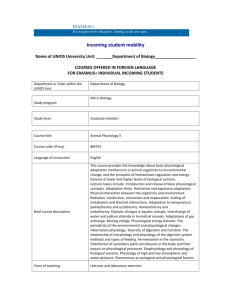Unknown Characteristics Chart
advertisement
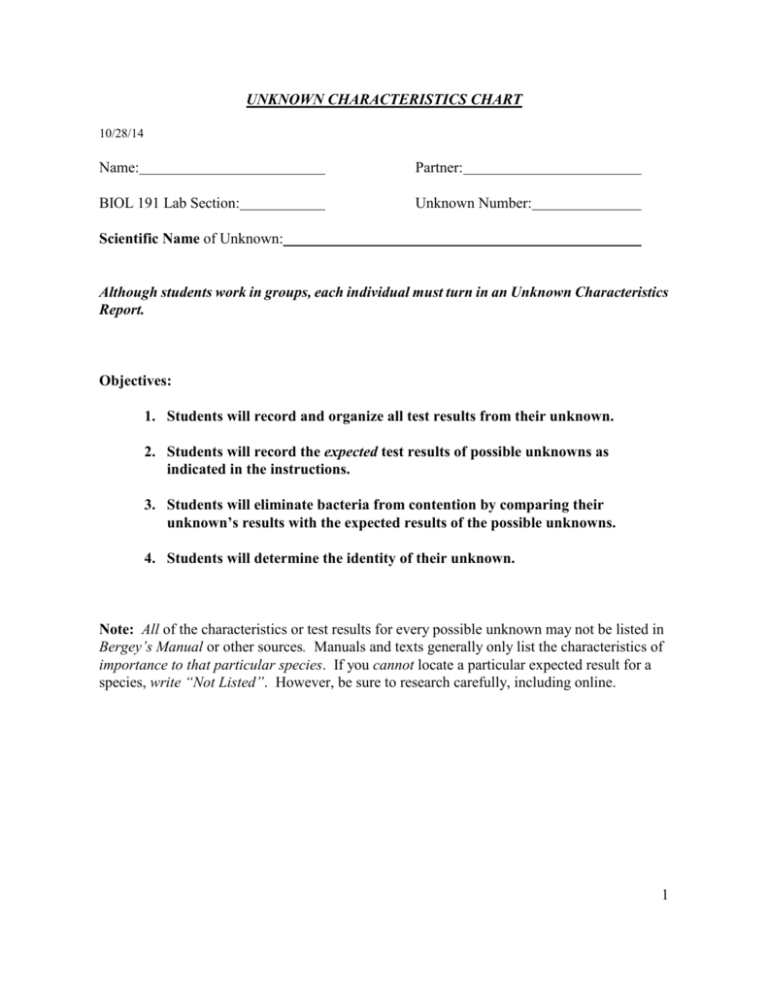
UNKNOWN CHARACTERISTICS CHART 10/28/14 Name: Partner: BIOL 191 Lab Section: Unknown Number: Scientific Name of Unknown: Although students work in groups, each individual must turn in an Unknown Characteristics Report. Objectives: 1. Students will record and organize all test results from their unknown. 2. Students will record the expected test results of possible unknowns as indicated in the instructions. 3. Students will eliminate bacteria from contention by comparing their unknown’s results with the expected results of the possible unknowns. 4. Students will determine the identity of their unknown. Note: All of the characteristics or test results for every possible unknown may not be listed in Bergey’s Manual or other sources. Manuals and texts generally only list the characteristics of importance to that particular species. If you cannot locate a particular expected result for a species, write “Not Listed”. However, be sure to research carefully, including online. 1 This report is organized into three sections: I. II. Morphological Characteristics (p. 3) Students must research and record the expected results for ALL of the possible unknowns. The Morphological Comparison Chart must be completed in order to compare your unknown with the other possible unknowns. Preliminary Elimination (p. 4) Based on the personal results of the morphological tests and comparative research, students will eliminate certain species from contention. III. Physiological Characteristics (pp. 5-6) Students will record their unknown’s results in the Physiological Test Comparison Chart. After eliminating species based on the morphological characteristics, write those remaining species in the chart and fill in their expected physiological characteristics. The chart is available for comparing your unknown with up to four similar species. Students will NOT perform every test listed (refer to the tables in the “Physiological Characteristics” lab instructions - p. 6). If you do NOT perform a particular test, do NOT research the expected results. Use the chart to easily compare those species most similar to your unknown. 2 I. Morphological Characteristics Research, in Bergey’s Manual or other manuals/texts, the morphological characteristics of ALL of the possible unknowns. Fill in the chart as follows: Cell Shape: bacillus (rod), coccus (spherical), curved Gram Stain: + or – Motility: + or – Spore formation: + or – Cell Shape Gram Stain Motility Spore formation Your results Bacillus megaterium Sporolactobacillus inulinus Mycobacterium smegmatis Staphylococcus aureus Staphylococcus epidermidis Streptococcus sanguis Micrococcus luteus Escherichia coli Enterobacter aerogenes Proteus vulgaris Pseudomonas aeruginosa 3 II. Preliminary Elimination: A. List all species eliminated based only on cell shape and Gram stain. B. IN DETAIL, explain why they were eliminated. Compare the eliminated species with your unknown. 4 III. Physiological Characteristics Students will not perform all tests listed, only those of importance for your species. 1. Write “NA” (Not Applicable) by any tests not to be performed (refer to the Tables in the ‘Physiological Characteristics’ student lab instructions). Do not research the expected test results of any species for tests that you do not perform. 2. Use Bergey’s or other manuals/texts to describe the expected physiological characteristics of those remaining possibilities, but only for the tests actually performed on your unknown. Therefore, you will write one of the following in each space in the Physiological Test Comparison Chart on the following page: 1) Your test result. 2) NA. 3) An expected test result (as listed in Bergey’s or other manuals/texts). 4) Not Listed (If the test is not listed in Bergey’s or other manuals/texts/online for that unknown). 5 TEST YOUR RESULTS Compare with… (Write possible unknown species here.) Compare with… (Write possible unknown species here.) Compare with… (Write possible unknown species here.) Compare with… (Write possible unknown species here.) LactoseFermentation Gas production SucroseFermentation Gas production GlucoseFermentation Gas production Methyl Red (MR in MR-VP) Voges-Pros. (VP in MR-VP) Indole Test in Tryptophane broth Urea Hydrolysis in urea broth Hemolysis on blood agar EMB – Colony color P. Isolation agarGrowth Pigmentation Catalase test on agar slant Mannitol Salt agarGrowth Fermentation Coagulase production 6


